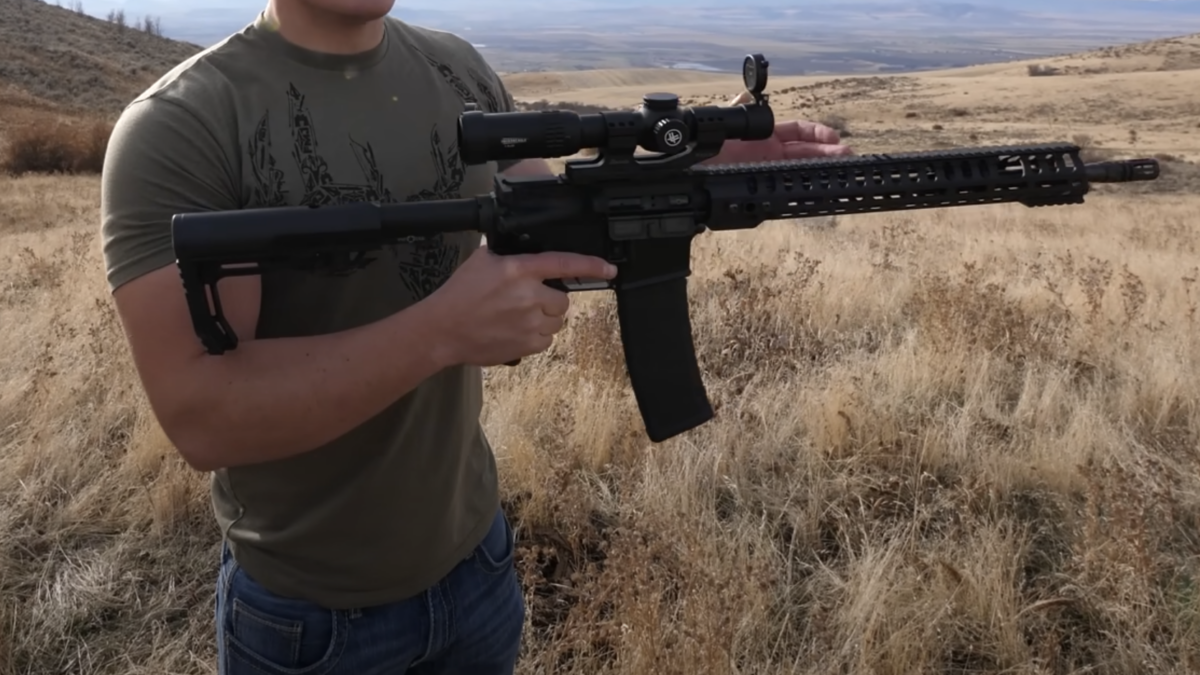The U.S. Supreme Court convened on Wednesday for oral arguments about whether the federal government was right to ban bump stocks on claims the assistive casing transforms semiautomatic rifles into machine guns.
The justices normally would use their questioning time to evaluate whether bump stocks qualify as “any weapon which shoots, is designed to shoot, or can be readily restored to shoot, automatically more than one shot, without manual reloading, by a single function of the trigger,” as defined in the 1934 National Firearms Act and Gun Control Act, which prohibits any device that results “in converting a weapon into a machinegun.”
Instead, oral arguments for Garland v. Cargill quickly devolved into confusing hypotheticals and debates that stemmed from justices’ incredibly limited understanding of how guns work.
Bump Stock Basics
Automatic weapons like machine guns are largely prohibited under U.S. law as dangerous and unusual because, with one trigger function, they can discharge hundreds of rounds per minute. Bump stocks, a simple casing added to the stock of a gun, merely aid shooters — especially those with disabilities — with trigger dexterity. The modifiers often do help shooters attain a faster rate of fire, but still require multiple trigger functions to achieve multiple shots.
The key differences between automatic and semiautomatic weapons with bump stocks were largely lost on the justices, especially Ketanji Brown Jackson and Elena Kagan, who repeatedly insisted bump stock-equipped guns can fire up to 800 rounds a second. They, along with the government’s legal team, repeated the lie that semiautomatic rifles with modifiers could fire hundreds of shots (in Kagan’s words, “a torrent of bullets”) each moment. Cargill lawyer Johnathan Mitchell corrected them multiple times.
“Why would even a person with arthritis think they needed to shoot 400 to seven or 800 rounds of ammunition under any circumstance if you don’t let a person without arthritis do that?” Kagan asked.
“They don’t shoot 400 to 700 rounds because the magazine only goes up to 50,” Mitchell explained, noting “rapid fire is not the test under the statute.” “So you’re still going to have to change the magazine after every round.”
Mitchell also repeatedly called out Jackson’s false assertion that firing a gun with a bump stock only requires one trigger movement.
“It’s factually incorrect to say that a function to the trigger automatically starts some chain reaction that propels multiple bullets from the gun. A function of the trigger fires one shot, then the shooter must take additional manual action,” Mitchell said.
Since, in Mitchell’s words, “the bump stock is neither necessary nor sufficient for the firing of the weapon,” the federal government’s attempt to outlaw bump stocks based on a provision about “the single function of the trigger” does not apply. Kagan later admitted “I don’t know about these things” but claimed that “textualism is not inconsistent with common sense.”
“At some point, you have to apply a little bit of common sense to the way you read a statute and understand that what the statute comprehends is a weapon that fires a multitude of shots with a single human action, whether it’s a continuous pressure on a conventional machine gun, pulling the trigger, or a continuous pressure on one of these devices on the barrel,” Kagan claimed.
Law-Abiding Gun Owners On The Hook
The Bureau of Alcohol, Tobacco, Firearms, and Explosives first outlawed the use of mechanical bump stocks shortly after they were invented in the early 2000s. Americans who owned non-mechanical bump stocks, however, could continue using them because the ATF determined those require the constant application of “forward pressure with the non-shooting hand and constant rearward pressure with the shooting hand.”
It was only after the 2017 Las Vegas shooter used bump stock-equipped rifles to kill 58 and injure hundreds more that the federal government decided to redefine its “machine gun” prohibition to include non-mechanical bump firing parts.
Congress moved to legislatively ban bump stocks shortly after the shooting but the ATF beat it to the punch, signaling it would propose a rule aimed at reversing “previous interpretation that non-mechanical bump stocks are not machineguns for purposes of the National Firearms Act and Gun Control Act.”
Approximately one year later, federal officials issued a rule classifying semiautomatic rifles with bump stocks as machine guns, which U.S. civilians are prohibited from owning without special federal permission. As a result, Americans like Texas gun store owner Michael Cargill were forced to destroy or surrender their lawfully acquired non-mechanical bump stocks to the government or face felony charges.
“Everything about the bump firing process is manual. There is no automated device such as a spring or a motor in any of Mr. Cargill’s non-mechanical bump stocks. The process depends entirely on human effort and exertion, as the shooter must continually and repeatedly thrust the force stock of the rifle forward with his nonshooting hand while simultaneously maintaining backward pressure on the weapon with his shooting hand,” Mitchell clarified.
The divided Sixth Circuit Court of Appeals ruled in 2021 that the bump stock ban was unconstitutional and no longer enforceable by the ATF. In 2023, the Fifth Circuit Court of Appeals similarly held the ATF did not have the authority to change bump stocks’ classification.
The federal government appealed, which led to the Supreme Court.
“The problem for the government is they’re not able to change the nature of the trigger that currently exists on a semiautomatic rifle simply by adding a bump stock, which is nothing more than a casing that allows the rifle the slide back and forth. The trigger is exactly the same as what it was before and the function of the trigger is exactly the same as what it was before,” Mitchell noted during oral arguments.
The ATF’s rush to rulemaking did not seem to sit well with Justice Neil Gorsuch. He noted that “through many administrations, the government took the position that these bump stocks are not machine guns.”
“And then you adopted an interpretive rule, not even a legislative rule, saying otherwise that would render a quarter of a million and a half million people federal felons. And not even through an APA process they could challenge, subject to 10 years in federal prison. And the only way they can challenge it is if they’re prosecuted.”
Gorsuch warned a government-led prosecution over ATF’s rushed bump stock rule could easily deprive law-abiding Americans “of guns or guns in the future, as well as a lot of other rights including the right to vote.”
U.S. Principal Deputy Solicitor General Brian Fletcher claimed the government sought to “maximize public notice” about the rule change through publication in the Federal Register.
“Because people will sit down and read the Federal Register. That’s what they do in their evening for fun. Gun owners across the country crack it open next to the fire,” Gorsuch remarked sarcastically.
Despite Gorsuch’s hesitation about the government’s rulemaking authority on bump stocks, Fletcher confirmed to Justice Samuel Alito that Americans who possessed bump stocks between 2018 and the Fifth Circuit’s decision would be eligible for prosecution by the government.
“I’m not aware of a lot of these prosecutions being brought, because we recognize that there is some legal uncertainty, but I think doctrinally that could happen all the time,” Fletcher said.
When Justice Brett Kavanaugh asked if someone unaware of the bump stock rule could be convicted, Fletcher reaffirmed that the government could and might prosecute them.









